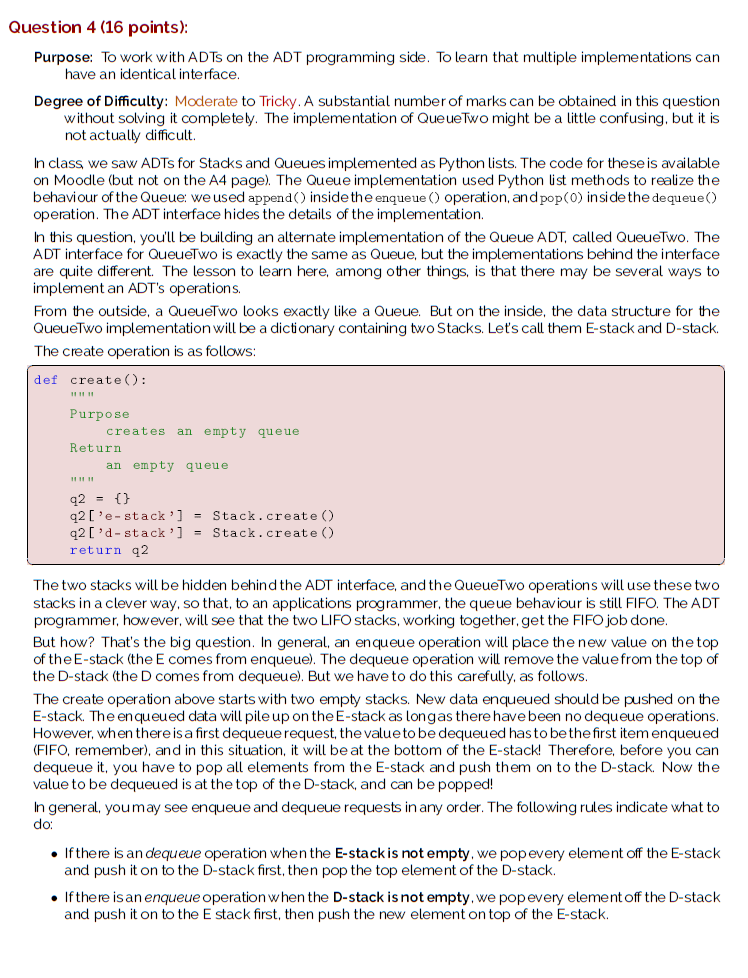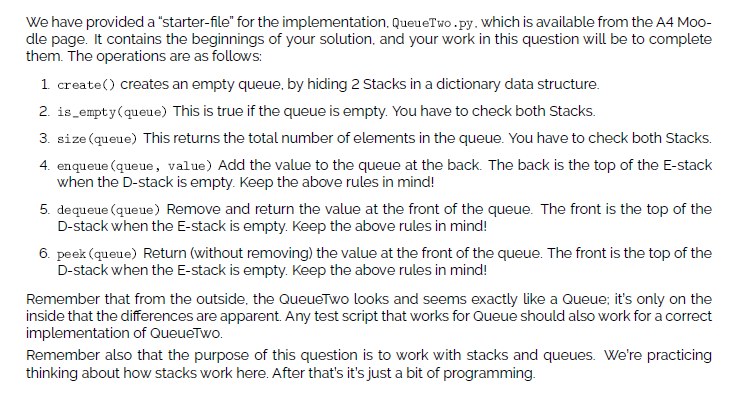Answered step by step
Verified Expert Solution
Question
1 Approved Answer
Python 3.x There is a lot to this question: Starter Code: import TStack as Stack def create(): Purpose creates an empty queue Return an
Python 3.x
There is a lot to this question:


Starter Code:
import TStack as Stack def create(): """ Purpose creates an empty queue Return an empty queue """ q2 = {} q2['e-stack'] = Stack.create() q2['d-stack'] = Stack.create() return q2 def is_empty(queue): """ Purpose checks if the given queue has no data in it Pre-conditions: queue is a queue created by create() Return: True if the queue has no data, or false otherwise """ return True def size(queue): """ Purpose returns the number of data values in the given queue Pre-conditions: queue: a queue created by create() Return: The number of data values in the queue """ return 0 def enqueue(queue, value): """ Purpose adds the given data value to the given queue Pre-conditions: queue: a queue created by create() value: data to be added Post-condition: the value is added to the queue Return: (none) """ return def dequeue(queue): """ Purpose removes and returns a data value from the given queue Pre-conditions: queue: a queue created by create() Post-condition: the first value is removed from the queue Return: the first value in the queue """ return None def peek(queue): """ Purpose returns the value from the front of given queue without removing it Pre-conditions: queue: a queue created by create() Post-condition: None Return: the value at the front of the queue """ return None
Tstack.py:
def create(): """ Purpose creates an empty stack Return an empty stack """ return '__Stack__',list() def is_empty(stack): """ Purpose checks if the given stack has no data in it Pre-conditions: stack is a stack created by create() Return: True if the stack has no data, or false otherwise """ if type(stack) is tuple: t,s = stack assert t == '__Stack__', 'Type Error : Expected __Stack__ but received '+t return len(s) == 0 else: assert False, 'Type Error: Expected __Stack__ but received '+str(type(stack)) def size(stack): """ Purpose returns the number of data values in the given stack Pre-conditions: stack: a stack created by create() Return: The number of data values in the queue """ if type(stack) is tuple: t,s = stack assert t == '__Stack__', 'Type Error: Expected __Stack__ but received '+t return len(s) else: assert False, 'Type Error: Expected __Stack__ but received '+str(type(stack)) def push(stack, value): """ Purpose adds the given data value to the given stack Pre-conditions: queue: a stack created by create() value: data to be added Post-condition: the value is added to the stack Return: (none) """ if type(stack) is tuple: t,s = stack assert t == '__Stack__', 'Type Error: Expected __Stack__ but received '+t s.append(value) else: assert False, 'Type Error: Expected __Stack__ but received '+str(type(stack)) def pop(stack): """ Purpose removes and returns a data value from the given stack Pre-conditions: stack: a stack created by create() Post-condition: the top value is removed from the stack Return: returns the value at the top of the stack """ if type(stack) is tuple: t,s = stack assert t == '__Stack__', 'Type Error: Expected __Stack__ but received '+t return s.pop() else: assert False, 'Type Error: Expected __Stack__ but received '+str(type(stack)) def peek(stack): """ Purpose returns the value from the front of given stack without removing it Pre-conditions: stack: a stack created by create() Post-condition: None Return: the value at the front of the stack """ if type(stack) is tuple: t,s = stack assert t == '__Stack__', 'Type Error: Expected __Stack__ but received '+t return s[-1] else: assert False, 'Type Error: Expected __Stack__ but received '+str(type(stack))
TQueue.py:
def create(): """ Purpose creates an empty queue Return an empty queue """ return '__Queue__',list() def is_empty(queue): """ Purpose checks if the given queue has no data in it Pre-conditions: queue is a queue created by create() Return: True if the queue has no data, or false otherwise """ if type(queue) is tuple: t,q = queue assert t == '__Queue__', 'Type Error: Expected __Queue__ but received '+t return len(q) == 0 else: assert False, 'Type Error: Expected __Queue__ but received '+str(type(queue)) def size(queue): """ Purpose returns the number of data values in the given queue Pre-conditions: queue: a queue created by create() Return: The number of data values in the queue """ if type(queue) is tuple: t,q = queue assert t == '__Queue__', 'Type Error: Expected __Queue__ but received '+t return len(q) else: assert False, 'Type Error: Expected __Queue__ but received '+str(type(queue)) def enqueue(queue, value): """ Purpose adds the given data value to the given queue Pre-conditions: queue: a queue created by create() value: data to be added Post-condition: the value is added to the queue Return: (none) """ if type(queue) is tuple: t,q = queue assert t == '__Queue__', 'Type Error: Expected __Queue__ but received '+t q.append(value) else: assert False, 'Type Error: Expected __Queue__ but received '+str(type(queue)) def dequeue(queue): """ Purpose removes and returns a data value from the given queue Pre-conditions: queue: a queue created by create() Post-condition: the first value is removed from the queue Return: the first value in the queue """ if type(queue) is tuple: t,q = queue assert t == '__Queue__', 'Type Error: Expected __Queue__ but received '+t return q.pop(0) else: assert False, 'Type Error: Expected __Queue__ but received '+str(type(queue)) def peek(queue): """ Purpose returns the value from the front of given queue without removing it Pre-conditions: queue: a queue created by create() Post-condition: None Return: the value at the front of the queue """ if type(queue) is tuple: t,q = queue assert t == '__Queue__', 'Type Error: Expected __Queue__ but received '+t return q[0] else: assert False, 'Type Error: Expected __Queue__ but received '+str(type(queue))
Question 4 (16 points) Purpose: To work with ADTs on the ADT programming side. To learn that multiple implementations can have an identical interface Degree of Difficulty: Moderate to Tricky.A substantial number of marks can be obtained in this question without solving it completely. The implementation of QueueTwo might be a little confusing, but it is not actually difficult. In class we saw ADTs for Stacks and Queues implemented as Python lists. The code for these is available on Moodle (but not on the A4 page). The Queue implementation used Python list methods to reaize the behaviour of the Queue we used append() ?nside the enqueue ( ) operation, and pop (0) ?nside the dequeue() operation. The ADT interface hides the details of the implementation. In this question, you'll be building an alternate implementation of the Queue ADT, called QueueTwo. The ADT interface for QueueTwo is exactly the same as Queue, but the implementations behind the interface are quite different. The lesson to learn here, among other things, is that there may be several ways to implement an ADT's operations. From the outside, a QueueTwo looks exactly like a Queue. But on the inside, the data structure for the QueueTwo implementation will be a dictionary containing twoStacks. Let's call them E-stack and D-stack. The create operation is as follows: def create(): Purpose creates an empty queue Return mpty queue q2 D 'e- stack'] Stack.create () q2[ 'd- stack'] Stack.create () return q2 The two stacks will be hidden behind the ADT interface, and the QueueTwo operations will use these two stacks in a clever way, so that, to an applications programmer, the queue behaviour is still FIFO. The ADT programmer, however, will see that the two LIFO stacks, working together.get the FIFO job done But how? That's the big question. In general, an enqueue operation will place the new value on the top of the E-stack (the E comes from enqueue). The dequeue operation will remove the value from the top of the D-stack (the D comes from dequeue). But we have to do this carefully, as follows. The create operation above starts with two empty stacks. New data enqueued should be pushed on the E-stack. The enqueued data will pile up on the E-stack as longas there havebeen no dequeue operations. However, when there is a first dequeuerequest, the valueto be dequeued has to be the first item enqueued (FIFO, remember), and in this situation, it will be at the bottom of the E-stack! Therefore, before you can dequeue it, you have to pop all elements from the E-stack and push them on to the D-stack. Now the value to be dequeued is at the top of the D-stack, and can be popped! In general, youmay see enqueue and dequeue requests in any order. The following rules indicate what to do: . If there is an dequeue operation when the E-stack is not empty. we popevery element off the E-stack and push it on to the D-stack first, then pop the top element of the D-stack. .If there is an enqueue operation when the D-stack is not empty.we pop every element off the D-stack and push it on to the E stack first, then push the new element on top of the E-stack
Step by Step Solution
There are 3 Steps involved in it
Step: 1

Get Instant Access to Expert-Tailored Solutions
See step-by-step solutions with expert insights and AI powered tools for academic success
Step: 2

Step: 3

Ace Your Homework with AI
Get the answers you need in no time with our AI-driven, step-by-step assistance
Get Started


